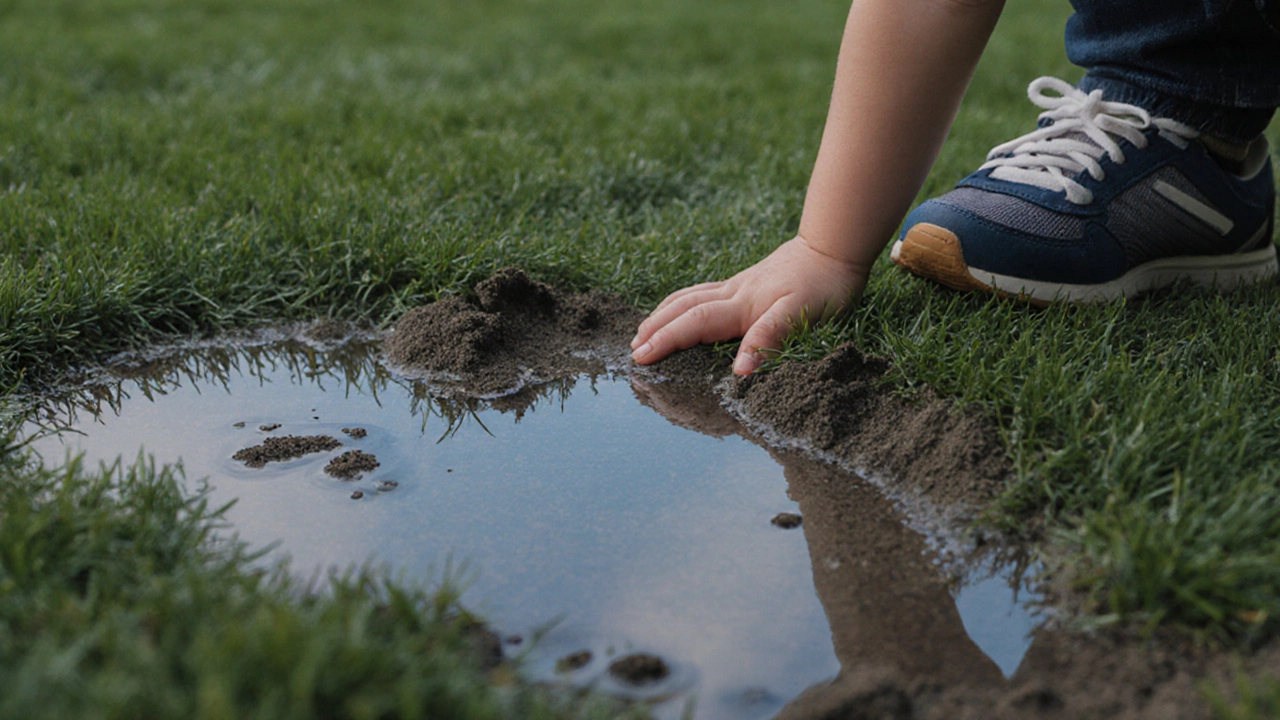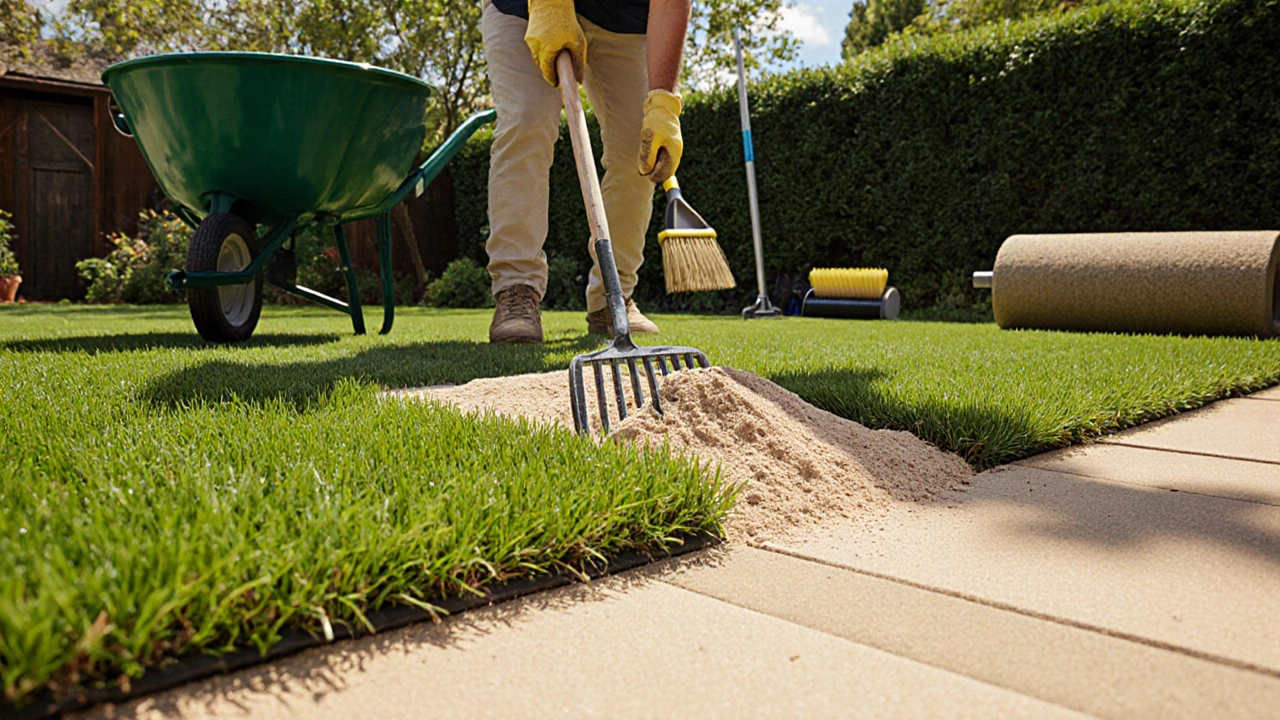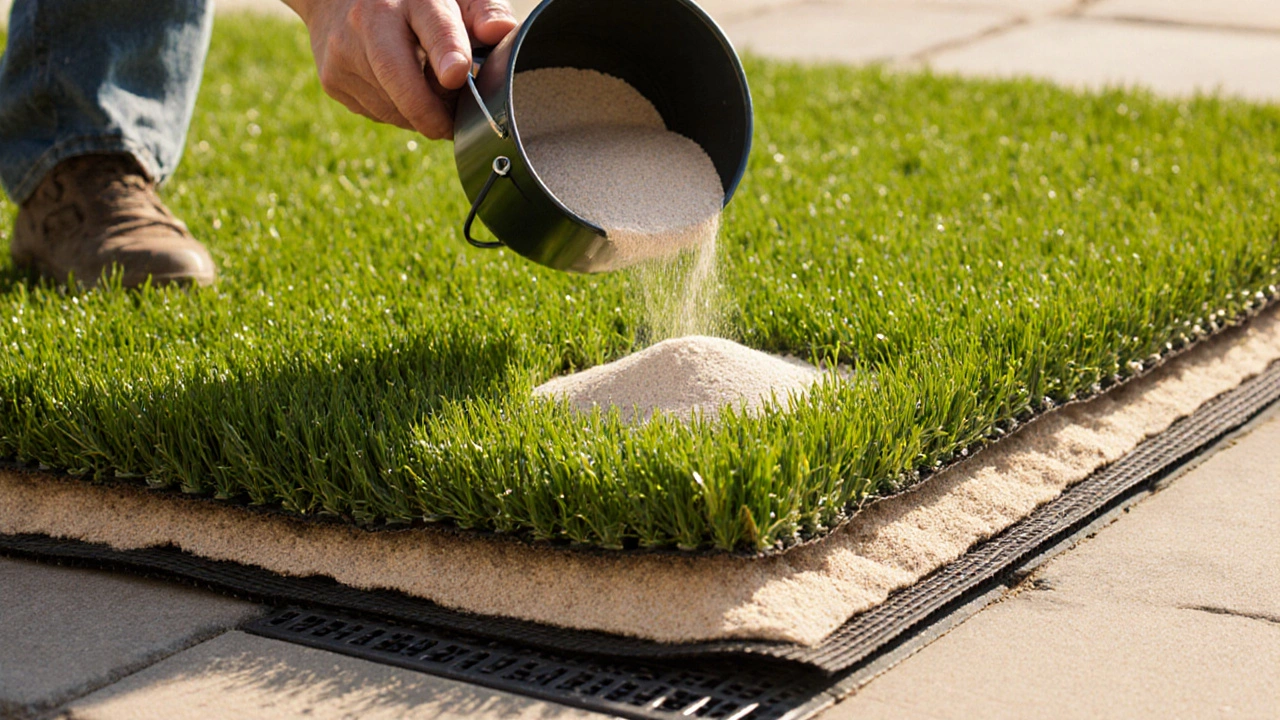Artificial Grass Sand Infill Calculator
Use this calculator to determine how much sand infill you should use for your artificial grass project based on the area and pile height.
Sand Infill Recommendation
When you first lay artificial grass, the sand you spread underneath feels like a simple way to keep things stable - but can you overdo it? The short answer is yes, and the consequences can turn a neat lawn into a slippery, soggy mess.
What is sand infill and why it matters
Sand Infill is a fine‑granular material that sits between the fibres of artificial grass. It adds weight, cushions foot traffic and helps the blades stay upright. Typical infill is silica sand, play sand or a special dehydrated sand product.
The sand works in concert with the Backing (the woven fabric that anchors the turf) and the Drainage Layer that lets water escape. Together they create a surface that looks like real grass but lasts longer with less upkeep.
How much sand should you use?
Most manufacturers give a rule of thumb: 1.5 to 2kg of sand per square metre for a standard 10mm pile height. If your turf has a taller pile (12‑15mm), bump the amount up to about 2.5kg/m². In practice, you can calculate the total weight by multiplying the square footage by the recommended kilograms.
For example, a 20m² patio would need roughly 30‑40kg of sand. Using a calibrated bucket (typically 10kg per bucket) makes the job quicker and reduces the risk of over‑pouring.

Signs you have too much sand
Overfilling isn’t always obvious at first, but watch for these clues:
- Water puddles linger after a light rain - the sand is blocking the Drainage Layer.
- The turf feels hard underfoot, like a concrete slab, rather than springy.
- Fibres begin to lay flat, creating a dull, lifeless look.
- Sand erupts through the surface when you walk, leaving gritty footprints.
If you notice any of these, you’re probably sitting on more sand than needed.
Why overfilling can damage your turf
Extra sand adds unnecessary weight, stressing the Backing and the stitching that holds the turf together. Over time, the seams can pull apart, leading to visible seams and uneven edges.
Compacted sand also reduces the natural give of the surface. This makes the lawn less comfortable for kids and pets, and it can increase the risk of injuries from falls. Finally, poor drainage can cause mold growth beneath the turf, which defeats the low‑maintenance promise of artificial grass.
How to fix an overfilled sand layer
Removing excess sand is a straightforward process if you follow these steps:
- Gather a sturdy garden rake and a flat‑bottomed shovel.
- Lift a corner of the turf at a time - most artificial grass is sewn onto Tuft (the individual fibre bundles). Gently separate the turf from the backing without tearing the stitches.
- Shovel out the visible sand, aiming for a depth that matches the manufacturer’s recommended level (usually 5‑7mm measured with a ruler).
- Even out the remaining sand using a brush or a compacting roller set on low pressure.
- Lay the turf back down, re‑stitch any seams, and brush the fibres upright with a stiff broom.
If the overfill is severe, you might need to lift the entire slab, replace the backing, and reinstall the turf - a task best left to professional installers.

Choosing the right sand - a quick comparison
| Sand Type | Particle Size | Water Drainage | Typical Cost (per kg) |
|---|---|---|---|
| Play Sand | 0.2‑0.6mm | Good | £0.04 |
| Silica Sand | 0.5‑1.0mm | Excellent (low compaction) | £0.06 |
| Dehydrated Sand | 0.3‑0.8mm | Very high (pre‑treated for flow) | £0.09 |
Silica sand is the most popular choice because its slightly larger grains slip past each other, reducing compaction. Play sand works for small residential patches, while dehydrated sand is ideal for high‑traffic commercial areas where drainage is critical.
Ongoing maintenance to keep sand levels in check
Even with the perfect initial fill, sand can shift over time. Here’s a quick maintenance routine:
- Brush the turf weekly with a stiff broom - this lifts the fibres and redistributes sand evenly.
- After heavy rain, inspect for pooling. If water sits, gently rake the sand to open drainage pathways.
- Every 6‑12months, use a sand‑leveling rake to smooth out low spots. Add a thin layer (about 1kg/m²) if you notice thinning.
- Check the seams for any pulling; re‑stitch if needed before the gap widens.
These simple habits keep your artificial grass looking fresh and prevent the sand from becoming a hidden liability.
Frequently Asked Questions
Can I use regular beach sand as infill?
Beach sand contains salt and organic debris that can corrode the backing and promote mold. Stick to clean, silica‑based sand sold for artificial turf.
How do I know if my sand is too compacted?
Press your hand into the surface; if the sand feels rock‑hard and doesn’t give, it’s over‑compacted. You should feel a slight give when you push down on the fibres.
Is it okay to add more sand after installation?
Yes, but only in thin layers (no more than 1kg/m² at a time) and after brushing the turf to ensure even distribution.
What if I notice mould under my artificial grass?
Mould usually signals poor drainage. Lift the turf, remove excess sand, and replace the drainage layer if needed. A professional inspection is advisable for large areas.
Can I mix sand with rubber granules?
Mixing is common for sports pitches: rubber adds cushioning while sand improves stability. Keep the total infill within the manufacturer’s weight limits to avoid overloading the backing.
